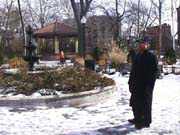Local leaders of community groups concerned with the welfare of city parks and historical sites were scheduled to meet this weekend in the auditorium of the Jersey City Museum, hoping to form a citywide coalition.
Clifford Waldman, founder of Friends of Van Vorst Park, who is organizing the meeting, feels that the groups can benefit by working together, offering each other models for success and a format for advocacy.
Waldman hopes to form a grass-roots coalition which would take the place of an appointed city planner as the final authority on the city’s planning projects.
“The laws need to be shifted,” said Waldman. “So the citywide coalition will safeguard that it is the people’s voice and the people’s vision that is taken into account with developments in parks and public spaces.”
Bureaucracy has been a barrier
Planning and development in the town is based on approval from the Planning Board and legislation of the City Council.
Waldman believes there is a chasm of communication between residents and government officials, which can be overcome with appropriate planning.
He first recognized a difficulty in dealing with the city in 1991, after the second child in 12 years was killed by a car while playing in Van Vorst Park. He formed the Friends of Van Vorst Park and implored the council to address what he considered a dangerous traffic situation.
FVVP eventually got the city to plant the mature pear trees that became a traffic barrier.
“It took years, though,” said Waldman. “We dealt with city officials, and it was the first time I experienced what dysfunctional bureaucrats looked like. Finally I turned to them at the end of 40 minutes of his shooting down every idea we came up with and I said ‘What do you suggest we do so we don’t have any more children killed?’
He looked right at me and said ‘I really don’t know.’ And he was content to leave the meeting like that. That was when I realized that if the people don’t do it, it’s really not going to happen.”
After having the trees planted, the FVVP took on the project of improving the park, transforming it from a place for drug dealers and broken glass into a community area for gardens and families.
Waldman believes that FVVP’s success can serve a model for the rest of the city.
“I think that with what’s been done in Van Vorst Park, that we have always been at the cutting edge of taking things to the next level,” said Waldman. “So far we have created the new standards, and people like them.”
Unique concerns, common needs
Dozens of different community groups exist in Jersey City, aiming to preserve parks such as Van Vorst, and also historical landmarks like the Loews Theater in Journal Square or the Speer Cemetery on Vroom Street.
“When it comes to something that has to do with the well-being of the neighborhood, the Loews and the park are identical in that they help to bring people together,” said Waldman. “In that way, it always needs to be the people who decide what’s best for that sort of thing.”
Rosalyn Browne, head of the Communipaw Avenue Block Association, hopes the coalition can help projects in her neighborhood aimed at turning abandoned properties and lots into positive areas for the community.
“Drug dealers use them to hang out and throw garbage in. It creates a safety and health hazard,” Browne said. “We would like to see them become a constructive project like a garden or a playground.”
Abandoned lots are often difficult to address because the owner may not be easily accessible. Browne has worked with city agencies such as the Department of Neighborhood Improvement to address the issues. She hopes the coalition will serve as a forum to share information and resources.
“Everyone has the same problems, and it’s always better when you have a bigger group together,” Browne said. “It’s a more creative way to solve a problem.”
Pershing Field Garden Friends is a year-old community-based organization located in the Heights area. Their mission is to improve Pershing Fields Park and to influence what happens to the adjacent reservoir. The group has a 60-person mailing list after starting with just six members last year.
“Cliff and the FVVP developed Van Vorst Park into a beautiful site,” said leader Laura Skolar. “It cost millions of dollars and we anticipate that the reservoir, to do anything of quality, will require vision. Because Cliff has done this before, he has the expertise and we want to hear his input.”
Grants, outreach and lobbying
Although he does not have a specific legal model in mind yet, Waldman hopes the coalition will eventually have the authority to represent the community’s needs. In addition to serving as a planning authority, the coalition can help in areas such as obtaining grants, researching projects, collaborating with fundraising projects, community policing and publicity.
“It’s very important that the greed of the developers or even the legitimate capitalistic intentions not lead to things that are bad for the community,” said Waldman.
Waldman also said that he supports development in concept. “Development needs to happen very much,” he said. “We need to restore enormous amounts of infrastructure to the historic district and build new parts of the city. Development is a good thing.”
Waldman refers to FVVP’s work as an example of how residents can create and complete projects. “People discovered that through our first getting trees and then getting the community gardens, and when we were able to formalize a master plan, that we actually got listened to,” Waldman said. “The residents started to realize that people can make a difference.”
Waldman created applications to distribute at Saturday’s meeting for any type of assistance needed for anyone interested in creating or improving a public space in their neighborhood. He hopes the applications will help paint a broader picture of what groups are out there looking for help.
